May 1, 2014
Station Spotlight: Cal State Stanislaus’ KCSS
Last Updated on May 1, 2014 by askcbiorg
Tell me a little history about your station and where your station is now?
[fusion_builder_container hundred_percent=”yes” overflow=”visible”][fusion_builder_row][fusion_builder_column type=”1_1″ background_position=”left top” background_color=”” border_size=”” border_color=”” border_style=”solid” spacing=”yes” background_image=”” background_repeat=”no-repeat” padding=”” margin_top=”0px” margin_bottom=”0px” class=”” id=”” animation_type=”” animation_speed=”0.3″ animation_direction=”left” hide_on_mobile=”no” center_content=”no” min_height=”none”]
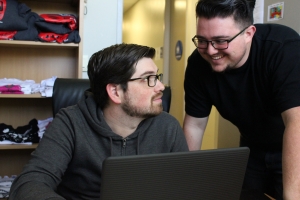
James and Clay at KCSS.
Clay Hobbs, station manager: KCSS started out in 1974 in a very small space with a window that faced students walking to and from class. We had a 10 watt transmitter and could only be heard on campus only. From 1985 to 1998 we had a 100 watt transmitter, and from 1998 to 2012 we used a 400 watt transmitter until it gave out the summer of 2012. We ran a 90 watt backup transmitter for almost a year to buy us time to approve and install the 6000 watt transmitter we have today.
Since the station has been established, we have introduced our webcasting and podcasts on KCSS.net. Our podcasts showcase students and volunteers talking about topics such as sports, “Saturday Night Live,” or music. We are also excited to use our new remote system so we can go out into the community and broadcast to bring more awareness to KCSS.
[/fusion_builder_column][fusion_builder_column type=”1_1″ background_position=”left top” background_color=”” border_size=”” border_color=”” border_style=”solid” spacing=”yes” background_image=”” background_repeat=”no-repeat” padding=”” margin_top=”0px” margin_bottom=”0px” class=”” id=”” animation_type=”” animation_speed=”0.3″ animation_direction=”left” hide_on_mobile=”no” center_content=”no” min_height=”none”]
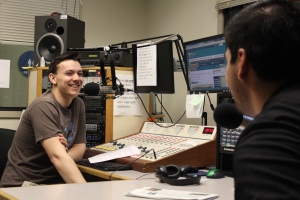
Brandon and Cam broadcasting live.
We like to reach out to the community in very fun ways. We host a big show once a year called The Bandstand and we have about 15 bands come out to a local restaurant and bar. We love having those shows every year to give back to the community that supports us and we have roughly 700 people come through and enjoy local music and good company.
KCSS is managed by students receiving internship credit and serves as a lab for two radio production courses. It is nice knowing that students are making KCSS a great radio station. I can tell that everybody likes to work here and that makes me feel accomplished and proud to be part of this student-run organization.
What sets your station apart from other college radio stations?
Hobbs: I think every college station has student interest and they are always trying to reach out to get more students listening and involved. KCSS has a really unique community listenership. Almost half of our broadcasters are volunteers and they are all very involved in the community. Our most seasoned broadcaster has been with us for over 20 years. We have California Bluegrass Association come in and play Bluegrass every Tuesday night from 7 p.m. to 9 p.m. Several professors on campus have a The Grateful Dead show from 10 p.m. to midnight on Tuesdays as well. Those volunteers have really helped us expand out into the community and gain very loyal listeners.
[/fusion_builder_column][fusion_builder_column type=”1_1″ background_position=”left top” background_color=”” border_size=”” border_color=”” border_style=”solid” spacing=”yes” background_image=”” background_repeat=”no-repeat” padding=”” margin_top=”0px” margin_bottom=”0px” class=”” id=”” animation_type=”” animation_speed=”0.3″ animation_direction=”left” hide_on_mobile=”no” center_content=”no” min_height=”none”]
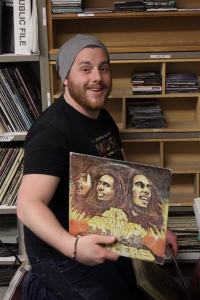
Darris in the library.
Why did you choose to work at the radio station?
Nicole Dunlap, Blues/Fat/Jazz/Reggae music director: I have always wanted to be involved in something. The summer before I started doing radio, I decided that I wanted to pursue a career in media. I decided to try to either work at my school’s newspaper or radio station. I felt that working at a radio station was the best option for me because I enjoy talking to people. I signed up for the radio production course. I was nervous when I first started, but I have enjoyed every minute of it. I then decided to become the music director, because I wanted to help our station advance. My experience here has been the best.
What’s the craziest thing you’ve ever done for your station?
Garrett Neely, production director: I can’t think of anything crazy necessarily, but one of our old station managers got us to start a softball team. We called ourselves “College Radio Magic.” The team didn’t win a lot of games but it was a blast. We even purchased our own baseball shirts that said “College Radio Magic” arced across the back.
[/fusion_builder_column][fusion_builder_column type=”1_1″ background_position=”left top” background_color=”” border_size=”” border_color=”” border_style=”solid” spacing=”yes” background_image=”” background_repeat=”no-repeat” padding=”” margin_top=”0px” margin_bottom=”0px” class=”” id=”” animation_type=”” animation_speed=”0.3″ animation_direction=”left” hide_on_mobile=”no” center_content=”no” min_height=”none”]
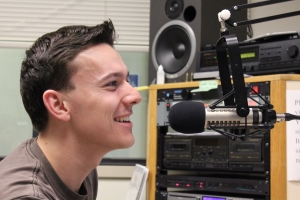
Brandon on the air.
Hobbs: We like to go out to video game releases and play some RPM/Dance music and try to get dance competitions started. It usually works, but that’s only after I get out there and start making a fool out of myself. It’s all in good fun and I usually get a few people really into it and they will be dancing in front of our booth all night.
What’s the best part of college radio? And the hardest part?
[/fusion_builder_column][fusion_builder_column type=”1_1″ background_position=”left top” background_color=”” border_size=”” border_color=”” border_style=”solid” spacing=”yes” background_image=”” background_repeat=”no-repeat” padding=”” margin_top=”0px” margin_bottom=”0px” class=”” id=”” animation_type=”” animation_speed=”0.3″ animation_direction=”left” hide_on_mobile=”no” center_content=”no” min_height=”none”]
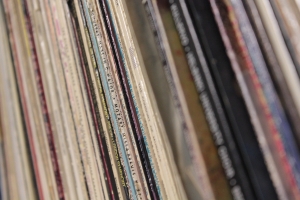
Vinyl for all!
Hobbs: The best part of college radio has to be the environment. There are stickers of bands everywhere, weird bands that you never heard but can’t stop listening to, and of course, the crazy good fun! I have been working here for four years now and I wish I could stay longer. KCSS is one big family and we all get along. The amount of fun we have makes this job not feel like work and I think that’s why we have such a great time doing what we do here. The hardest part about college radio is being a student that is trying to get by with a full school schedule and two other jobs. At times, we can get spread thin here at the station but we always pitch in and help each other so we can get our jobs done. The best parts of college radio definitely outweigh the hardest parts.
[/fusion_builder_column][/fusion_builder_row][/fusion_builder_container]








